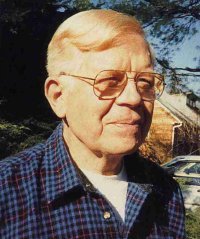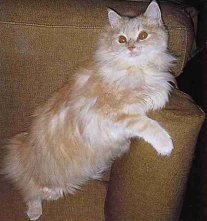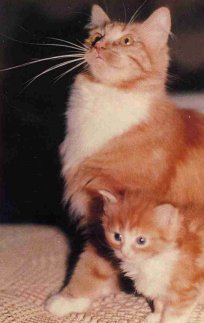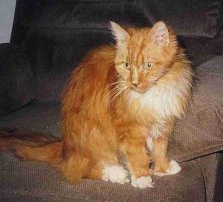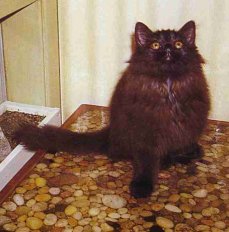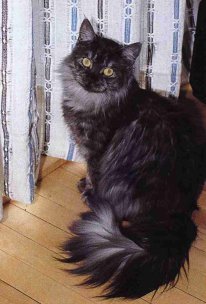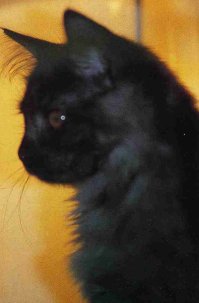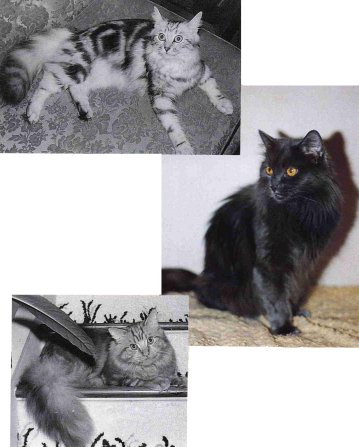| "This page was originally a part of the Maine Coon Heritage Site, a site that was first created in 1998 by Cynthia Bowen (Coontopia), Ulrika Olsson (Ylletrollets), Astrid Straver (Tricks and Tails) and Janet Marr (Furkats). It was then taken over by PawPeds, and it is now split up to fit better with the structure of PawPeds' website." |
 |
JoStad Cattery - Di Everett
Di Everett interviews a major Maine Coon Foundation breeder
From the 1960s - Dr Rod Ljostad
|
Dr Rod Ljostad |
Talking to Dr Rod Ljostad (the 'L' is silent) really does make Maine Coon history come to life, with his extensive peripheral knowledge coming out in such casual asides as "Of course, different colours were often to be found on different islands around the Maine coast - white on one, red on the other, and so on..." Rarely is a JoStad cat visible on our current written pedigrees and yet who has not heard of these cats and how many of us do not have the JoStad cattery name behind our lines, if we care to research them back to their beginnings? Rod and his late wife, Betty, were heavily instrumental back in August 1968 in getting the Maine Coon Breeders' and Fanciers' Association under way, under the Presidency of Dr E E (Gene) Eminhizer, with Rod as Vice-president and Betty as Secretary. They, along with the other founder members of the organisation, worked hard to get the MCBFA Standard of Points accepted as the standard with all the registering organisations of that time, including many of which we hear very little these days.
Rod says that he and Betty chose to have cats, in the beginning, not specifically Maine Coons. They had started many years before they had ever heard of the breed, with a kitten they obtained from the Bronx (and he still remembers the precise address!) on their way one day to their cabin in the woods in New Jersey. They all lived happily together until the cat eventually died of old age, at which point they decided it might be nicer to breed a cat for themselves and started with Siamese (and at this point Rod says, with his typical quiet, wry humour, that it naturally didn't stop with breeding a cat for them - they soon used up all their friends as homes for free kittens; but they were hooked!) A friend came one day to look at the Siamese and told Rod and Betty all about showing cats, so they began exhibiting, attending their first show at Westchester County Center, New York, finalling their Siamese cats from time to time and generally beginning to enjoy 'the cat world'.
Searching for litters
|
Whittemore's Hester |
After a while, Rod saw in National Geographic magazine an article on cats, written by Richard Gebhardt, later CFA President, in which was included one picture of a Maine Coon cat. They liked the look of the cat and began looking for one but with no luck for some time. They camped every Summer at Acadia National Park, on Mount Desert Island in Maine and, on the way up there, asked in gas stations all along the war if anyone knew of anyone with litters of Maine Coon kittens; but still no luck. At last, they found an advertisement in Cats magazine for Mrs Ethelyn Whittemore's cattery in Augusta and travelled up to see the cats, arranging to return six weeks later for their chosen kitten; which is how Jennifer came to join the Ljostad household. Rod now says that Jennifer, a tortie, was too wide in the head and not the best Maine Coon ever but she had a nice personality and did reasonably well at shows, where the couple made new friends and became deeply involved with the breed. (He comments that one of the things which he discovered and loved about the Maine Coon was the war "you can tell them 'Don't do that' and they look you right in the eye and say "Go to Hell!".) There was little animosity at the shows during this time since, in those days, Maine Coons never finalled in the rings which, Rod says, kept the Persian exhibitors happy!
This was when MCBFA emerged, since ACFA and ACA each had their own brief SoPs and it was time to tighten up and even out the look and style of the cats. Rod describes the many meetings between the founders, beneath the old charter oak tree in his garden, where they discussed and argued the Standards and which methods should be used to change them. Eventually, it was decided to make it a truly democratic choice and breeders were balloted for their opinion. This was a long and complicated process. In those days, the colours on exhibition were more evenly spread than one tends to see, these days, and with the various colours went the various 'looks' which are still occasionally evident today. Some of the foundation cats, Rod admits, looked like household pets, although many were good examples of the Maine Coon breed. The fact remained that one had to be very careful when breeding from foundation and a really good and comprehensive Standard had to be set to encourage people to breed for good type.
Founding the MCBFA
|
Mather with kitten |
As a beginning, the Committee used a 5-point scale for the muzzle, from short through medium to long. They wanted to include the profile, length of legs, body and tail, front and side views, etc., which was a daunting task. In order to standardise from what was being used at the time, they used slides of various cats and projectors to enlarge and reduce, superimposing one picture on top of another until they had what they considered to be the right blend. Then outline drawings were made of the 'possibles' and were sent out in a mail ballot. With each ballot, three choices were included and very often, the vote would be tied and, after narrowing down some more, would have to be reballoted. But, Rod says, they simply persisted and finally reached a consensus of opinion which suited everyone, and Gene Eminhizer was able to create a single Standard of Points to be presented to all the organisations. (It was still some time before all organisations took up the MCBFA SoP - but it was a great beginning.)
|
Mather |
MCBFA members were kept up to date with what was happening by The Scratch Sheet, conceived and first published in January 1969 and, as if anyone needed telling, still thriving today with much the same philosophy as when it started - to provide something for everyone; breeder, exhibitor and fancier alike. Over the years, there have been many other clubs also taking the Maine Coon to heart - the UMCCA, a CFF organisation with Helen and George Andre (Illya) and Connie Condit (Heidi Ho) as staunch supporters; the Central Maine Cat Club, an all-breed, non-affiliated club from long before the days we are talking of here, whose rise and fall is closely documented in Maine Coon history; the International Maine Coon Club, started by a splinter group of just three or four breeders; and the Maine Coon Cat Club, still a large and thriving club today. But the MCBFA remains the largest of all, begun from the Ljostad's house and garden almost thirty years ago and now with a vast American and ever-growing international membership.
| Sire Linden of War-Tell 15 Feb 1968 ACA 60541-3 CFA 820-0004 CFF 100M3-33890 |
GrSire Whittemore's Sam-bo CFF 100M2-33311 |
GGrSire Whittemore's Schiller CFF 101M-30722-R1 |
Smokie Joe of Whittemore |
| Tortilla | |||
| GGrDam Whittemore's Fluffy CFF 101F-30627-R1 |
Smokie Joe of Whittemore | ||
| Princess Sue | |||
| GrDam Whittemore's Mid-Nite CFF 100F2-33312 |
GGrSire Sammie of Whittemore CFF 101M-30624-R1 |
Smokie Joe of Whittemore | |
| Ginger of Whitemore | |||
| GGrDam Whittemore's Tigress CFF 101F-30628-R1 |
Smokie Joe of Whittemore | ||
| Sno Queen | |||
| Dam Whittemore's Jennifer of JoStad 2 Mar 1968 ACA 60954-2 CFF 101F2-33731 |
GrSire Sammie of Whittemore CFF 101M-30624-R1 |
GGrSire Smokie Joe of Whittemore CFF 101M1-36438-R2 |
|
| GGrDam Ginger of Whitemore CFF 101F1-36439-R2 |
|||
| GrDam Whittemore's Dinah CFF 101E-30720-R1 |
GGrSire Sammie of Whittemore CFF 101M-30624-R1 |
Smokie Joe of Whittemore | |
| Ginger of Whitemore | |||
| GGrDam Whittemore's Tigress CFF 101F-30628-R1 |
Smokie Joe of Whittemore | ||
| Sno Queen |
|
Jennifer |
During the time that they were so busy with the formation of the club, Rod and Betty were equally busy establishing their JoStad Maine Coon cattery and were breeding from two foundation queens. It was not difficult then to find a stud cat to use, since everyone knew everyone else - and all the Maine Coons in their area - and the first stud cats Rod and Betty used were Rose Levy's (Harobed) Eric the Red and Florence Wartell's Linden of War-Tell (as shown on the pedigree above). The first stud cat of their own was Whittemore Stephani Loki, a solid blue boy who belonged at first to a lady called Stephanie, who then went off to college and needed a home for the cat. Rod and Betty adopted him and his name is seen in the background of many pedigrees.
All their cats lived in the house - six of their own and, for a time, 10 of Connie Condit's. (For those of you who read the Heidi Ho profile in the last issue, you will remember Connie's 'cat transporter'. Rod says it spent quite some time parked up in his driveway!) He then built a cattery attached to and accessed from the house, which is now his art studio/workshop (and, I have to say, a fascinating place in which to delve around!) For all their deep involvement with the breed, they always viewed their breeding as a hobby, albeit a very rewarding one. Betty was very fussy about whom she would allow to take their kittens and wasn't keen on selling to breeders, so most went as pets. Rod says they were very happy with their life - they loved their cats and kittens and most of the 'cat people' they met were very kind.
Wonderful longhairs
|
Patience |
When asked the question we always put to foundation breeders, Rod says honestly that he no longer feels that there is a place - or necessity - for foundation cats in our breed. He feels that the gene pool is now quite large enough to be used beneficially, if used wisely, and that the cats have progressed in the right direction. He does, however, feel that the current trend toward extreme length is encouraging the cats to become too long-legged and skinny. He points out that the Standard says 'rectangular' and feels that this is being misinterpreted in the extreme body length of many of today's cats although the overall size is an improvement on the smaller cats of his breeding days. Back in 'those days', everyone was encouraged to show as many colour variations as possible and he regrets the passing of the even colour spread at shows and the current prevalence of the brown tabby but comments that the 'modern' Maine Coon has one big advantage - the breed has become consistent, these days; the cats can look like brother and sister, across the board. In his day, he says, many of the cats looked like 'wonderful longhairs' but not always as a breed.
|
Prudence |
Asked about the relative merits of their own cats, Rod names JoStad's Penelope as the most successful for showing, achieving several 'Bests'. He is, though, quick to point out that 'a Best was not so difficult, if yours was the only cat or one of just two or three!' For breeding, however, he feels they all contributed something, with each of them having something different about them but each extreme being no worse, when used in the breeding program, than any other. He pointed out Annabelle for the particular personality they loved so much in their cats. Annabelle, a very pretty silver tabby lady, was still there, at my feet and stealing my home-made cookies, elderly but still fishing her toys out of the toy basket and chasing them around the carpet as I talked to Rod; a perfect example of the temperament we should all like to see in our cats.
One of the traits heavily prevalent in the Maine Coons at the time we were discussing was polydactylism, affecting up to 40% of the naturally-bred Maine Cats. It was hoped at that time to include this trait as a possible variation in the Standard, and a polydactyl SoP was created with a clause reading 'may have extra toes ' but it soon became obvious that it would take years to get it accepted and the MCBFA therefore put it to a members' vale in yet another mail ballot. The membership voted against and the polydactyl Standard was never submitted to the registries. Rod and Betty had one polydactyl female, called Martha, but they only ever bred pets from her.
Working with Foundation stock
This was just one of the pitfalls of working with foundation stock. It would have been all too easy to establish firmly in the breed many undesirable characteristics, had these early breeders not been as careful and as responsible as they were with their breeding practices. It is well-documented that many of the original cats were inbred or closely line-bred, in an attempt to identify possible recessive genetic faults, and Rod says that many of the early breeders made a point of studying genetics to make sure they were doing the best they could to avoid perpetuating any problem they had identified along the way.
|
top: Annabelle |
Other than this, Rod says they all had to work with what was available and simply make the best of what they had, being careful to stop when necessary and not continue with faults or bad type and to let all offspring from these breedings go as pets. He still believes that it is better to work with a mediocre cat with no specific faults than with a cat which looks stunning but has one outstanding fault to pass on down the line. He and Betty were most interested in the solid colourings, without white, and concentrated on blues, reds and creams. For the 1976 Centennial, they bred what was then the closest they had come to a red, white and blue kitten - a blue cream and white, which was featured in an article in the New York Times. Rod has his own opinion: 'It was a terrible, messy-looking kitten...!'
Another JoStad claim to fame was a cat called Tina Muffett. Bred by Rod and Betty and owned by Helen Lynch, a close family friend, Tina was a cream Maine Coon who was used as an advertisement for 'Moist Meals'. She had, as Helen remembers fondly, a great liking for cashew nuts!
Rod now lives peacefully in retirement - well, at least from the teaching profession - in his home in Westchester, New York. His cattery-now-workshop is home to his cat posts, which he builds and sells, and to a million other projects-on-the-go. He still belongs to the Maine Coon Cat Club being, in fact, its only Honorary Member and is always to be met at its annual eastern USA show. It was a delight to talk to him and my only abiding regret is that I had to rush of the same afternoon to catch my flight home - or else I might still be sitting there gossiping now!
© "Maine Coon International", issue 7, 1996.
Reprinted with permission.

